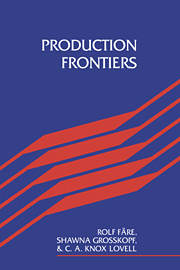Book contents
- Frontmatter
- Contents
- List of Figures
- List of Tables
- Preface
- 1 Introduction
- 2 Production Technology
- 3 Input-Based Efficiency Measurement
- 4 Output-Based Efficiency Measurement
- 5 Indirect Input-Based Efficiency Measurement
- 6 Indirect Output-Based Efficiency Measurement
- 7 The Measurement of Price Efficiency
- 8 Graph Efficiency Measurement
- 9 Efficiency Measurement and Productivity Measurement
- 10 Topics in Efficiency Measurement
- A Standard Notations and Mathematical Appendix
- References
- Biographical Index
- Index
4 - Output-Based Efficiency Measurement
Published online by Cambridge University Press: 23 October 2009
- Frontmatter
- Contents
- List of Figures
- List of Tables
- Preface
- 1 Introduction
- 2 Production Technology
- 3 Input-Based Efficiency Measurement
- 4 Output-Based Efficiency Measurement
- 5 Indirect Input-Based Efficiency Measurement
- 6 Indirect Output-Based Efficiency Measurement
- 7 The Measurement of Price Efficiency
- 8 Graph Efficiency Measurement
- 9 Efficiency Measurement and Productivity Measurement
- 10 Topics in Efficiency Measurement
- A Standard Notations and Mathematical Appendix
- References
- Biographical Index
- Index
Summary
Introduction
In Chapter 3 we modeled technology in terms of the input correspondence and measured efficiency relative to the input set, i.e., output quantities were taken as given and inefficiency identified by feasible reductions in input quantities or cost. In this chapter we measure efficiency relative to the output set P(x), i.e., we take input quantities as given and judge performance by the ability to increase output quantities or revenue. As such the topic of this chapter is very much in the spirit of the neoclassical production functions defined as maximum achievable output given input quantities and technology, although we generalize here to the case of multiple rather than scalar output.
In Section 4.1 output-based measures which are independent of prices, i.e., technical in nature, are introduced, and we show how overall technical efficiency can be decomposed into three component measures – scale, congestion, and purely technical efficiency. All of these measures of technical efficiency take input quantities as given and measure efficiency as feasible proportional expansion of all outputs.
In Section 4.2 we turn to output price-dependent measures of efficiency, the goal being to maximize revenue rather than to proportionally increase outputs. Here it becomes relevant to alter the output mix in light of existing output prices. In particular, we show how to decompose overall revenue efficiency (defined as the ratio of maximum to observed revenue) into technicaland allocative components.
Sections 4.1 and 4.2 focus on what we call radial measures of output efficiency. One of the drawbacks of these radial measures is that they project an observation onto the isoquant of the output set, and not necessarily onto the efficient subset of the output set.
- Type
- Chapter
- Information
- Production Frontiers , pp. 95 - 127Publisher: Cambridge University PressPrint publication year: 1993



